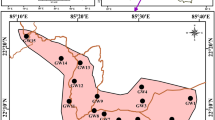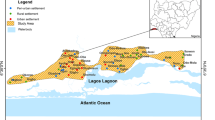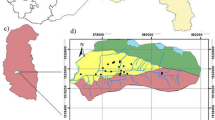Abstract
Tripura is a water-rich administrative state in the Northeastern part of India. Though groundwater is the main source of drinking water, groundwater monitoring and historical data on the groundwater quality of this state is relatively scarce. This study aims to identify the sources and processes controlling the hydrochemical evolution of groundwater in Hezamara block in Tripura. Interpretation of measured parameters using geochemical plots, analysis of ionic ratios, multivariate statistical techniques, and spatial interpolation methods indicated both natural and anthropogenic sources. Results show that precipitation is the dominant process controlling the groundwater quality followed by rock–water interaction. Carbonate dissolution and silicate weathering were the major geochemical processes. The findings showed that the concentration of few heavy metals (iron, manganese, and lead) exceeded the drinking water quality standards. Evaluation of the results through various heavy-metal indices showed that several locations exceeded the limits and pose a risk to humans. Potential non-carcinogenic risk through the drinking water pathway was also identified. Pollution mapping indicates that only less than 1 km2 of the study area is suitable for drinking use. This study recommends installation of public drinking water supply in this area to reduce the impact of heavy-metal contamination on human health. Moreover, the water should be treated before supplying for public use.








Similar content being viewed by others
References
APHA (2005) Standard methods for the examination of water and wastewater, 21st edn. American Health Public Association, WWA, Washington, DC
Backman B, Bodiš D, Lahermo P, Rapant S, Tarvainen T (1998) Application of a groundwater contamination index in Finland and Slovakia. Environ Geol 36:55–64
Banerjee S, Das B, Umlong IM, Devi RR, Kalita H, Saikia LB, Borah K, Raul PK, Singh L (2011) Heavy metal contaminants of underground water in Indo Bangla border districts of Tripura, India. Int J Chem Tech Res 3:516–522
BIS (2012) Indian standard drinking water specification. Second Revision ISO: 10500:2012, Bureau of Indian Standards, Drinking Water Sectional Committee, FAD 25. BIS, New Delhi
Bouzourra H, Bouhlila R, Elango L, Slama F, Ouslati N (2015) Characterization of mechanisms and processes of groundwater salinization in irrigated coastal area using statistics, GIS, and hydrogeochemical investigations. Environ Sci Pollut Res 22:2643–2660
Brahma J, Sircar A, Karmakar GP (2013) Hydrocarbon prospectivity in central part of Tripura, India, using an integrated approach. J Geogr Geol 5:116–134
Brindha K, Elango L (2015) Cross comparison of five popular groundwater pollution vulnerability index approaches. J Hydrol 524:597–613
Brindha K, Neena Vaman KV, Srinivasan K, Sathis Babu M, Elango L (2013) Identification of surface water-groundwater interaction by hydrogeochemical indicators and assessing its suitability for drinking and irrigational purposes in Chennai, Southern India. Appl Water Sci 4:159–174
Brindha K, Pavelic P, Sotoukee T, Douangsavanh S, Elango L (2016) Geochemical Characteristics and Groundwater Quality in the Vientiane Plain, Laos. Expos Health 9:89–104
Census of India (2011) Population of India. http://www.censusindia.gov.in/2011-Common/CensusData2011.html. Accessed 17 Jan 2019
CGWB (2012a) Ground Water Information Booklet North Tripura District, Tripura. Central Ground Water Board, North Eastern Region, Ministry of Water Resources, Guwahati, p 16
CGWB (2012b) Ground Water Information Booklet South Tripura District, Tripura. Central Ground Water Board, North Eastern Region, Ministry of Water Resources, Guwahati, p 18
CGWB (2016) Ground Water Year Book, North Eastern Region. Central Ground Water Board, North Eastern Region, Ministry of Water Resources, Guwahati, p 112
Chakraborti D, Rahman MM, Mukherjee A, Alauddin M, Hassan M, Dutta RN, Pati S, Mukherjee SC, Roy S, Quamruzzman Q, Rahman M, Morshed S, Islam T, Sorif S, Selim M, Islam MR, Hossain MM (2015) Groundwater arsenic contamination in Bangladesh—21 Years of research. J Trace Elem Med Biol 31:237–248
Chakraborty K, Sudhakar S, Sarma KK, Raju PLN, Das AK (2018) Recognizing the rapid expansion of rubber plantation—a threat to native forest in parts of northeast India. Curr Sci 114:207–213
Christensen TH, Bjerg PL, Banwart SA, Jakobsen R, Heron G, Albrechtsen H-J (2000) Characterization of redox conditions in groundwater contaminant plumes. J Contam Hydrol 45:165–241
Das N, Deka JP, Shim J, Patel AK, Kumar A, Sarma KP, Kumar M (2016) Effect of river proximity on the arsenic and fluoride distribution in the aquifers of the Brahmaputra Floodplains, Assam, Northeast India. Groundw Sustain Dev 2–3:130–142
Di Curzio D, Palmucci W, Rusi S, Signanini P (2016) Evaluation of processes controlling Fe and Mn contamination in the San Pedro Sula porous aquifer (North Western Honduras). Rend Online Soc Geol It 41:42–45
Döll P, Müller Schmied H, Schuh C, Portmann FT, Eicker A (2014) Global-scale assessment of groundwater depletion and related groundwater abstractions: combining hydrological modeling with information from well observations and GRACE satellites. Water Resour Res 50:5698–5720
Donohue S, McCarthy V, Rafferty P, Orr A, Flynn R (2015) Geophysical and hydrogeological characterisation of the impacts of on-site wastewater treatment discharge to groundwater in a poorly productive bedrock aquifer. Sci Total Environ 523:109–119
Drever JI (1988) The geochemistry of natural waters, 2nd edn. Prentice Hall, Englewood Cliffs, p 437
Edet AE, Offiong OE (2002) Evaluation of water quality pollution indices for heavy metal contamination monitoring. A study case from Akpabuyo-Odukpani area, Lower Cross River Basin (southeastern Nigeria). GeoJournal 57:295–304
Elango L, Brindha K, Kalpana L, Sunny F, Nair RN, Murugan R (2012) Groundwater flow and radionuclide decay-chain transport modelling around a proposed uranium tailings pond in India. Hydrogeol J 20:797–812
Elumalai V, Brindha K, Sithole B, Lakshmanan E (2017) Spatial interpolation methods and geostatistics for mapping groundwater contamination in a coastal area. Environ Sci Pollut Res 24:11601–11617
Ficklin WH, Plumlee GS, Smith KS, McHugh JB (1992) Geo-chemical classification of mine drainages and natural drainages in mineralized areas. In: Kharaka YK, Maest AS (eds) Water–rock interaction: seventh international symposium on water–rock interaction. A.A. Balkema, Rotterdam, pp 381–384
Ghosh S, Sar P (2013) Identification and characterization of metabolic properties of bacterial populations recovered from arsenic contaminated ground water of North East India (Assam). Water Res 47:6992–7005
Gibbs RJ (1970) Mechanisms controlling world water chemistry. Science 170
Gong G, Mattevada S, O’Bryant SE (2014) Comparison of the accuracy of kriging and IDW interpolations in estimating groundwater arsenic concentrations in Texas. Environ Res 130:59–69
Gowrisankar G, Chelliah R, Ramakrishnan SR, Elumalai V, Dhanamadhavan S, Brindha K, Antony U, Elango L (2017) Chemical, microbial and antibiotic susceptibility analyses of groundwater after a major flood event in Chennai. Nat Sci Data 4:170135
GSI (2011) Geology and mineral resources of Manipur, Mizoram, Nagaland and Tripura. Geological Society of India, Government of India, Bangalore
Henderson T (1985) Geochemistry of groundwater in two sandstone aquifer systems in the Northern Great Plains in parts of Montana and Wyoming. Regional aquifer-system analysis, US Geological Survey professional paper; 1402-C, pp C69–C72
Hossain MF (2006) Arsenic contamination in Bangladesh—An overview. Agr Ecosyst Environ 113:1–16
ICMR (2009) Nutrient requirements and recommended dietary allowances for Indians. A report of the expert group of the Indian Council of Medical Research (ICMR), Hyderabad, India, p 334
Jahanshahi R, Zare M (2015) Assessment of heavy metals pollution in groundwater of Golgohar iron ore mine area, Iran. Environ Earth Sci 74:505–520
Karroum M, Elgettafi M, Elmandour A, Wilske C, Himi M, Casas A (2017) Geochemical processes controlling groundwater quality under semi arid environment: a case study in central Morocco. Sci Total Environ 609:1140–1151
Kshetrimayum KS, Hegeu H (2016) The state of toxicity and cause of elevated Iron and Manganese concentrations in surface water and groundwater around Naga Thrust of Assam-Arakan basin, Northeastern India. Environ Earth Sci 75:604
Kumar M, Das A, Das N, Goswami R, Singh UK (2016) Co-occurrence perspective of arsenic and fluoride in the groundwater of Diphu, Assam, Northeastern India. Chemosphere 150:227–238
Liao Q, Deng Y, Shi X, Sun Y, Duan W, Wu J (2018) Delineation of contaminant plume for an inorganic contaminated site using electrical resistivity tomography: comparison with direct-push technique. Environ Monit Assess 190:187
Machiwal D, Jha MK (2015) Identifying sources of groundwater contamination in a hard-rock aquifer system using multivariate statistical analyses and GIS-based geostatistical modeling techniques. J Hydrol Region Stud 4:80–110
Magesh NS, Chandrasekar N, Elango L (2017) Trace element concentrations in the groundwater of the Tamiraparani river basin, South India: insights from human health risk and multivariate statistical techniques. Chemosphere 185:468–479
Mahanta C (2006) Water resources of the Northeast: state of the knowledge base. Indian Institute of Technology, Guwahati, p 22
Mahanta C, Enmark G, Nordborg D, Sracek O, Nath B, Nickson RT, Herbert R, Jacks G, Mukherjee A, Ramanathan AL, Choudhury R, Bhattacharya P (2015) Hydrogeochemical controls on mobilization of arsenic in groundwater of a part of Brahmaputra river floodplain, India. J Hydrol Region Stud 4:154–171
McMahon PB, Chapelle FH (2008) Redox processes and water quality of selected principal aquifer systems. Ground Water 46:259–271
Mohan SV, Nithila P, Reddy SJ (1996) Estimation of heavy metals in drinking water and development of heavy metal pollution index. J Environ Sci Health Part A Environ Sci Eng Toxicol 31:283–289
Mokadem N, Boughariou E, Mudarra M, Ben Brahim F, Andreo B, Hamed Y, Bouri S (2018) Mapping potential zones for groundwater recharge and its evaluation in arid environments using a GIS approach: case study of North Gafsa Basin (Central Tunisia). J Afr Earth Sc 141:107–117
Moore DS, Notz W, Fligner MA (2013) The basic practice of statistics, 6th edn. W. H. Freeman and Company, New York, p 754
Nandy DR, Dasgupta S, Sarkar K, Gang A (1983) Tectonic evolution of Tripura–Mizoram fold belt, Surma Basin, Northeast India. Q J Geol Min Met Soc India 55:186–194
Oinam JD, Ramanathan AL, Singh G (2012) Geochemical and statistical evaluation of groundwater in Imphal and Thoubal district of Manipur, India. J Asian Earth Sci 48:136–149
Palmucci W, Rusi S, Di Curzio D (2016) Mobilisation processes responsible for iron and manganese contamination of groundwater in Central Adriatic Italy. Environ Sci Pollut Res 23:11790–11805
Paul R, Das S, Nag SK, Singh MK (2016) Deciphering groundwater quality for drinking and irrigation purposes—a study in Lefunga block of West Tripura district, Tripura, India. J Earth Sci Clim Change 7:1000378
Planning Commission (2011) Report of the working group on rural domestic water and sanitation, Twelfth five year plan—2012–2017. Ministry of Drinking Water and Sanitation, Government of India, New Delhi, p 220
Rajesh R, Brindha K, Murugan R, Elango L (2011) Influence of hydrogeochemical processes on temporal changes in groundwater quality in a part of Nalgonda district, Andhra Pradesh, India. Environ Earth Sci 65:1203–1213
Rajmohan N, Elango L (2004) Identification and evolution of hydrogeochemical processes in the groundwater environment in an area of the Palar and Cheyyar River Basins, Southern India. Environ Geol 46:47–61
Rodell M, Velicogna I, Famiglietti JS (2009) Satellite-based estimates of groundwater depletion in India. Nature 460:999–1002
SENES Consultants India Pvt. Ltd. (2015) EIA for BMDE Development well in Baramura Field, Tripura, p 172
Sharma UC, Sharma V (2011) Managing socio-economic and hydrological risks in northeast India. Risk in water resources management, vol 347. IAHS Publications, Melbourne
Shepard D (1968) A two-dimensional interpolation function for irregularly-spaced data. In: Proceedings of the 1968 ACM national conference, pp 517–524
Singh AK, Kumar SR (2015) Quality assessment of groundwater for drinking and irrigation use in semi-urban area of Tripura, India. Ecol Environ Conserv 21:97–198
Tamasi G, Cini R (2004) Heavy metals in drinking waters from Mount Amiata (Tuscany, Italy). Possible risks from arsenic for public health in the Province of Siena. Sci Total Environ 327:41–51
UNDESA (2013) World Population Prospects. Population Division Database. Detailed indicators 2012 Revision. United Nations Department of Economic and Social AffairsNew York, Washington DC
UNESCO (1984) Ground water in hard rocks. United Nations Educational, Scientific and Cultural Organization, Paris, p 217
U.S.EPA (1989) Risk assessment guidance for superfund, volume 1: human health evaluation manual (part A). United States Environmental Protection Agency, Office of Emergency and Remedial Response, Washington DC
U.S.EPA (2011) Exposure Factors Handbook: 2011 Edition. Environmental Protection Agency, National Center for Environmental Assessment, Washington, DC
Wada Y, van Beek LPH, van Kempen CM, Reckman JWTM, Vasak S, Bierkens MFP (2010) Global depletion of groundwater resources. Geophys Res Lett 37:L20402
World Bank (2010) Deep wells and prudence: towards pragmatic action for addressing groundwater overexploitation in India, p 97
Yihdego Y, Al-Weshah RA (2017) Assessment and prediction of saline sea water transport in groundwater using 3-D numerical modelling. Environ Processes 4:49–73
Zikmund WG (2000) Business research methods, 6th edn. Thomson/South-Western Publishers, Mason, p 742
Acknowledgements
We thank Mr. Sathis Babu for his help in preparing the base map of the study area and Mr. Anbarasan Anbhazagan for his input on the statistical methods. Authors from Tripura University would like to acknowledge the Head of the Department of Chemistry, Tripura University for providing laboratory support to carry out the analysis of water samples. We thank the three anonymous reviewers for their insightful comments on the manuscript.
Author information
Authors and Affiliations
Corresponding author
Additional information
Publisher's Note
Springer Nature remains neutral with regard to jurisdictional claims in published maps and institutional affiliations.
Electronic supplementary material
Below is the link to the electronic supplementary material.
Rights and permissions
About this article
Cite this article
Paul, R., Brindha, K., Gowrisankar, G. et al. Identification of hydrogeochemical processes controlling groundwater quality in Tripura, Northeast India using evaluation indices, GIS, and multivariate statistical methods. Environ Earth Sci 78, 470 (2019). https://doi.org/10.1007/s12665-019-8479-6
Received:
Accepted:
Published:
DOI: https://doi.org/10.1007/s12665-019-8479-6




